Estudios originales
← vista completaPublicado el 29 de septiembre de 2017 | http://doi.org/10.5867/medwave.2017.08.7049
Expectativas hacia el consumo de alcohol en niños escolares entre 8 y 12 años de edad: estudio descriptivo
Expectations towards alcohol consumption in school children between 8 and 12 years of age: a descriptive study
Abstract
INTRODUCTION The World Health Organization (WHO) indicates that the consumption of alcoholic beverages at social gatherings is common in many parts of the world and can have negative health and social consequences. Early initiation of alcohol use is a major risk factor for the development of patterns of abusive consumption of alcohol.
OBJECTIVES To analyze the expectations towards alcohol consumption and to identify the age of onset of alcohol use in school children between 8 and 12 years of age.
METHODS The study was exploratory, descriptive and cross-sectional. Data were collected from February to March, 2016, at the elementary schools Prof. Claudio Cortés Castro and Manuel Prieto Diaz in the city of Villahermosa, Tabasco. The questionnaire of expectations towards alcohol for children was applied.
RESULTS Sample size was 203 children. Twenty eight percent of children had consumed alcohol once in life; mean age of consumption onset was between 8 and 9 years old. Most frequently, the drink was beer, mostly provided by the father in places of family life. Among alcohol consumption expectations, dimensions scoring higher were aggressiveness and sociability and the dimension scoring lower was that of negative states.
CONCLUSION With respect to expectations towards alcohol consumption, children think that consuming alcohol promotes aggressive behavior followed by swear words, disturbing other people and discussing with them. In contrast, there are situations produced by alcohol consumption that children fail to appreciate, such as sadness and shame.
Introduction
Alcohol is a psychoactive substance with properties that cause dependence that has been widely used in many cultures for centuries. The harmful consumption of alcohol carries a severe social and economic burden for societies [1].
The World Health Organization (WHO) pointed out that the consumption of alcoholic beverages in social gatherings is frequent in many parts of the world though it may produce negative health and social consequences related to its toxic properties and dependence. Furthermore, some chronic diseases may affect those persons who drink large amounts of alcohol over several years. Alcohol consumption is also associated with an increase in the risk of acute conditions, such as injuries, particularly those caused by traffic accidents [2]. WHO mentions that alcohol consumption affects people and societies in different ways and its effects are determined by the volume of alcohol consumed, consumption habits and, rarely, the quality of alcohol. In 2012 alcohol was the cause of 3.3 million deaths, which means 5.9% of the world total. In the 20-39 age range group, 25% of the deaths are attributable to alcohol consumption [3].
Early onset of alcohol consumption represents a significant risk factor for the development patterns to excessive alcohol consumption [4].
Alcohol expectations are the ideas about the effects that alcohol produces on behavior, mood and emotions, regardless of the consumption of alcoholic beverages. The perception of contingency between a certain behavior and results leads to the storage of associations in the brain. The influence of these associations tends to generate a behavior in the future, in this case, deciding whether consuming alcohol or not [5]. Studies carried out in other countries, show alcohol consumption among children is mostly experimental, and cases of moderate consumption are recorded in low-frequency [6].
Alcohol expectations have been shown to be strongly associated with alcohol consumption in children and adolescents, and mediated by variables such as age [7]. Research about the behavior of alcohol consumption and the background information about it in children and adolescents are sparse [8].
Grigoravicius et al. (2013) performed in Argentina, a study with a clinical (children attending psychoanalytic psychotherapy) and a non-clinical sample (children of a public school). This study shows that almost all children, in both samples, have consumed alcohol in family life such as birthdays, Christmas, New Year, among others. All sample results showed that 78% (14 cases) of the clinical population and 69% (9 cases) of the non-clinical population had been drinking since 8-10 years of age [9].
While research in the area of expectations towards alcohol consumption has increased since its emergence in the 70's; many studies are not focused in this construct. This is due, in part to the absence of local instruments to assess alcohol expectations sustained by children in our environment. In this context, and with the purpose of fulfilling this absence, two kinds of questionnaires were constructed, the Alcohol Expectations Questionnaire for Adolescents and the Alcohol Expectations Questionnaire for Children [10].
According to the previous figures, a percentage of the children population who have tried alcohol in social and family gatherings can be noticed. These figures and actions should not be ignored, and they are the reason to study this phenomenon. I t is disturbing that the age in which children initiate alcohol consumption varies between eight and ten years. In addition, the population sees this legal drug as a fundamental part of family coexistence and gatherings. Thus, it is important to know the expectations that children have about alcohol consumption, even in those who have already consumed alcohol in their short life period.
It is important to emphasize that the results of this study contribute to the design and implementation of future nursing interventions. These could focus on the evidence to reduce alcohol intake, and guidance to parents from the family life cycle. Undoubtedly, the goal of nursing care is to maintain a state of well-being for people and their families, and also to reduce risk factors for unhealthy behaviors. Therefore, the following research questions arise: what are the expectations for alcohol consumption and what is the age of onset of alcohol consumption in school- children between eight and twelve years of age?
Methods
Data collection was carried out by the authors of the research. It took place in the facilities of two elementary schools in Villahermosa, Tabasco under the authorization of each school.
The steps for data collection began with parental consent through the signing of informed consent. In this document they were informed that the participation of their children would be anonymous and confidential. Of the participating children whose parents first signed written informed consent, verbal consent was then obtained to participate in the study. The data from the instruments were collected during February to March 2016.
In order for the children's responses to the use of alcohol and their effects to be reliable, it was necessary to recognize the drinks on which they were being asked in the questionnaires, for this, they were shown a printed sheet where they illustrate the Alcoholic beverages, soft drinks, among others, they were asked to point out the different beverages to avoid errors in the results of research or reading and/or comprehension, data collection was carried out individually to children 8-10 years of Age, and 11-12 year old carried out the questionnaire in groups using pencil and paper [10]. A timetable was drawn up of the dates in which the data were collected in the space and time allowed by the managers of each school.
In order for children's responses to alcohol use and its effects to be reliable, they need to recognize the drinks they are being asked about in the questionnaires. For this, they were shown a printed sheet illustrating alcoholic and soft drinks, among others. The children were asked to point out the different drinks on the slide to avoid reading errors and / or comprehension in the results. Data collection was done individually for children aged eight to ten years. On the other hand, with the 11 and 12 year olds data collection was carried out with pencil and paper measurements in a group format [10]. A timetable was drawn up for the dates in which the data were collected in the space and time allowed by the managers of each school.
This is an exploratory and descriptive study due to the objective of identifying the expectations towards alcohol consumption in children between 8 and 12 years of age. It is also cross-sectional because it involves obtaining data at a specific time [11].
The study population consisted of children aged 8 to 12 years old from elementary schools Claudio Cortes Castro and Manuel Díaz Prieto in Villahermosa, Tabasco. A convenience sampling scheme was used.
The sample consisted of 203 children, whose parents previously authorized their participation in the study by signing the informed consent, as established in articles 24 and 36 of the Regulations of the General Law on Health in the Field of Research for Health [12]. Another ethical aspect indicated in the regulation and considered for the present study is the one indicated in the article 13 that mentions that in all investigation in which a human being is subject of study, the criterion of respect to his or her dignity and the protection of his or her rights and welfare must prevail. As established in article 35, it was previously ensured that similar studies have been done on people of the same age group. The article 36, which mentions that for the investigation of minors or incapacitated, the written informed consent of those who exercise parental authority or legal representation of the child must be obtained. When two persons exercise the parental authority of a minor, the consent of only one of them is admissible, solely if there is a conclusive or manifest impossibility of the other to provide it or in case of imminent risk to the child's or the disabled person´s health or life.
Also, according to article 17, this study is considered in the category without risk. This is due to the fact that there is no intentional intervention or modification in the physiological, psychological and social variables of the individuals participating in the study, using only a questionnaire to collect the data. Finally, written permission was obtained from an inter-institutional ethics committee.
The instruments used for this study were a socio-demographic data record in which variables such as age, sex and school grade were collected. With the second instrument, data about the history of alcohol consumption were obtained through the following questions:
- Do you usually drink alcohol at home?
- Do your friends consume alcoholic beverages?
- Have you ever consumed alcohol in your life?
- At what age was your first experience with alcohol?
- What kind of drink did you have?
- How did you get the booze?
The third instrument is the Alcohol Expectations Questionnaire for Children [10]; conformed by 30 items applied without modifications. The response scale is of Likert-type (1 = never, 2 = seldom, 3 = many times, 4 = always). It consists of five factors: the first factor called risk and aggression (items 7, 11, 14, 16, 19, 23, 26, 29, and 30), the second factor, identified as increase in sociability (items 1, 4, 9, 12, 15, 18, 21), the third factor perception of negative states (items 3, 8, 17, 20 and 24), the fourth factor feelings of anger and safety (items 2, 5, 6 and 10) and the last factor relaxation and reduction of tension (items 13, 22, 25, 27, and 28). The total score ranges from 30 to 120 where higher scores mean higher expectations for alcohol consumption. It means that with higher scores expectations are positive in the sense of being present and with lower scores expectations are negative in the sense of being absent in children [10].
The presentation of the results of the main expectations is made from the score obtained (sums and means). Thus, we find expectations that will get higher scores and are pointed out, since they are the most frequent in the children. We also consider reporting the results of the expectations that scored lowest.
The reliability of the instrument was obtained by calculating Cronbach alpha coefficient for the global scale (α= 0.85) and for each of the five scales. So, we had a high α value (0.83) for the risk and aggressiveness subscale. The remaining four scales had moderate, but adequate values of internal consistency (sociability: α = 0.74; relaxation: α = 0.75, negative states perception: α = 0.75 and anger: α = 0.71) [10].
Results
The sample consisted of 203 children. The prevailing age range is that of 10 and 11 years of age with 47.3%. Girls represent 55.7% of the sample. On the other hand, 28.6% are children in the sixth grade (Table 1).
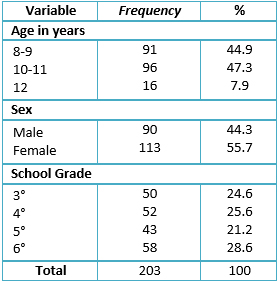 Full size
Full size Regarding history of alcohol consumption, 18.7% indicate that they tend to drink alcohol at home, 2.5% indicate that their friends consume alcoholic beverages and 28.6% have consumed alcohol at least once in their life (Table 2).
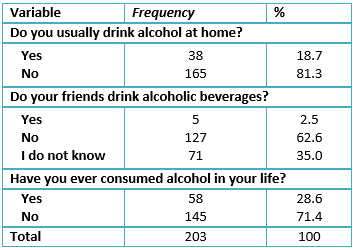 Full size
Full size The ages in which the children had their first experience with alcohol most frequently was from eight to nine years (43.1%) and from 10 to 11 (36.2%); the rest of the children mentioned that it occurred between four and five years (12%); 6.8% had their first experience between six and seven years. One child did not remember the age at which he took his/her first drink (Table 3).
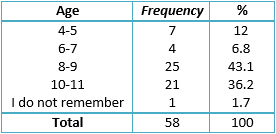 Full size
Full size The most frequent alcoholic beverage consumed in their first alcohol experience was beer with a 48.2%, followed by eggnog (rompope) (24.1%) and cider (17.2%). The other beverages with less frequency are wine, tequila, whisky and vodka (Table 4). The children mention that the place they first tried an alcoholic beverage was within their own family, mainly provided by the father (29.3%), the family (20.6%), and the mother (10.3%) and, less frequently, the uncle, aunt and grandfather. There were nine cases in which the children tried and alcoholic beverage by their own means (Table 5).
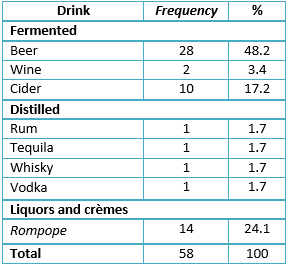 Full size
Full size  Full size
Full size In relation to the expectation of alcohol consumption, the items with the highest score as a result of the sum of points belong to the risk-aggressiveness and sociability category. So, we found that children mainly perceive that alcohol makes people say bad words, argue with others as well as annoy them and that they become aggressive. Within the category of sociability children perceive that alcohol makes people have more fun at a party (Table 6).
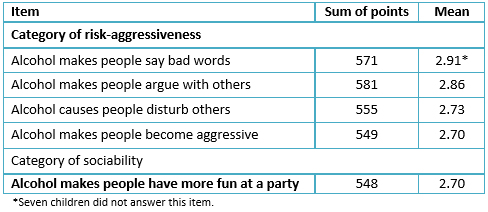 Full size
Full size Following the expectations of alcohol consumption, within the sociability dimension there are items related to the expectations that children perceive to a lesser extent. So we find that children do not have many expectations about alcohol consumption in relation to making people more sympathetic, nor that alcohol makes people do things that make others laugh. In the category of negative states, children have no expectations that alcohol will make people feel ashamed about what they do when they drink, or that alcohol makes people feel sad. Something similar occurs in the dimension of anger and safety, regarding the category stating alcohol has to do with the fact the people feel prettier than others (Table 7).
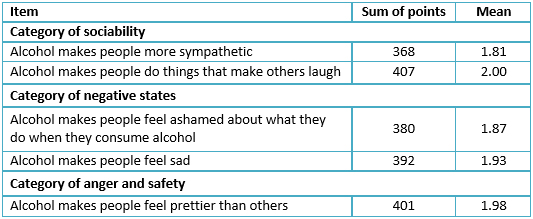 Full size
Full size Discussion
The results of this research study in the case of socio-demographic variables allowed to identify that almost half of the population are boys between 10 and 11 years of age and more than half are girls.
In relation to the first experience or contact with an alcoholic beverage, we found that 28.6% of the total population are children who have consumed alcohol once in their life and that the average age in which it was consumed was between 8 and 9 years. This fact coincides with the study conducted by Rivas et al. where the age of onset of alcohol consumption was eight years in boys and nine years in girls in the city of Villahermosa, Tabasco [13]. In other studies about alcohol consumption, figures show that people with relatives who consume a lot of alcohol, start consuming it at earlier ages than those who do not have relatives who are frequent alcohol consumers [14], [15], [16].
Children also report that their friends drink alcoholic beverages and 28.6% of the sample has ingested alcohol at least once, most of them between the ages of eight and nine years (12.3%). In the Duffy study, it was found that 28.4% of the sample had at least once consumed alcohol in their lifetime between eight and ten years [17].
On the other hand, Pilatti et al. showed that more than half of the children had consumed alcoholic beverages at least once. They also found that among males the probability of finding direct experiences of alcohol consumption is higher, because men consume alcoholic beverages more often, but not in more quantity than women. In our study we found men are those who show the highest percentage related to the first experience with alcohol, although there is not much difference from women [10].
Nowadays, alcohol consumption does not distinguish sex anymore. Some years ago the consumption of alcohol was only associated to men as main consumers, today this thought has changed, recent studies about this topic indicate that percentages are almost the same. This phenomenon has been studied and it has been found that there is no difference of percentages between men and women at the moment of consuming alcohol [18].
The most consumed alcoholic beverage is beer, followed by eggnog and cider; these beverages are easy to get in family gatherings. This result is similar to that of Amaro et al. where the most consumed drinks were beer and wine [19].
Children said they obtained the alcoholic beverage for the first time from the same family, mainly the father, mother and uncle. It should be emphasized that the family, as a variable, plays the role of facilitator and this same variable is a factor that indicates the age of consumption of alcohol in the students [14].
In the visit prior to the application of the surveys, pictures of alcoholic beverages were shown to the children for them to recognize the beverages and so avoid mistakes in the results of the study. At the time of displaying the pictures, children expressed orally that the beverages were present at parties, 15th birthdays´ celebrations, weddings and Christmas parties. It was noted that most of them wrote that the alcoholic beverage was obtained in such celebrations. About the reasons for alcohol consumption, children stated that having fun and having a good time is the ultimate goal pursued by the adults when they consume alcohol.
Consumption situations are linked mainly with celebrations or parties like Christmas and football. This means that alcohol consumption is an act to celebrate something and share [20]. It should be mention it is often believed that children obtain alcohol not from the family but for example, from friends [9], [17], [21]. In our study, the alcoholic beverages were provided by the same family members and not by outsiders.
About expectations towards alcohol consumption in children, the items with the highest scores are within the categories of risk-aggressiveness and sociability. The study by Grigoravicius et al. has similar results; it shows statistically significant values for the association between sociability, anger and safety scales, and for the sum of positive expectations [9]. Thus, it is clear that children see that people act aggressively, say swear words, disturb other people and discuss with them as the effect of alcohol. These data indicate that when alcohol is consumed it produces negative effects manifested as verbal and physical violence [22]. Results are similar to those reported by Pastén et al. who revealed that the magnitude of aggressive behavior lies in the consumption of alcohol and drugs, and it was in this aspect where children indicated the highest levels in terms of aggressiveness [23].
Another category with a high score is sociability which means children observe alcohol consumption as a way to have fun at parties. Moll and Charpentier, in their bibliographic review, conclude that children aged 7 to 12 years begin consumption for fun [24].
There are few studies from research groups devoted to alcohol consumption in children. Those that have been done show as a result that children associate alcohol consumption with fun at parties, laughing a lot, and doing things that amuse others [25]. Once again the same results emerge from this study. In this regard, we can mention that either in Argentina, Chile or Mexico, among other countries, the expectations towards alcohol consumption in children continue to have the same sense. It is related to a form of recreation, socialization or celebration, being part of the Mexican traditions and culture, in this case.
It is important to note that in our study there are items with lower scores. This means that there are situations where children are not appreciating behaviors that are a consequence of alcohol consumption. These situations are: when people feel ashamed about what they do when they drink and when alcohol makes people feel sad; these items are within the dimension of negative states. According to these results, children from our study do not distinguish that alcohol can generate shame in people for what they do when they are under the influence of alcohol and, on the other hand, that they may feel sad when they are alcoholic.
Conclusions
There are children who mention having consumed alcohol at least once, the average age at which they first consumed it was between eight and nine years old.
The most frequently consumed alcoholic beverage was beer. This drink has mostly been provided mainly by the father followed by other family members like mother, uncle or aunt in situations like family gatherings and weddings.
Regarding the expectations towards alcohol consumption, there is relevance in the categories of risk and aggressiveness and sociability, where there are positive expectations. This means children think that alcohol consumption can lead to an aggressive behavior and this could make them say swear words, disturb other people and argue with them. On the other hand, there are situations generated by alcohol that children fail to appreciate, such as negative states. These include the fact that alcohol makes people feel sad and embarrassed about their behavior.
Notes
From the editor
The authors originally submitted this article in Spanish and subsequently translated it into English. The Journal has not copyedited this version.
Ethical aspects
The Journal is aware that the Institutional Commission on Ethics in Research at the Juárez Autónoma de Tabasco University, Mexico, was informed about this study and its possible publication in a biomedical journal.
Declaration of conflicts of interest
The authors have completed the ICMJE Conflict of Interest declaration form, and declare that they have not received funding for the report; have no financial relationships with organizations that might have an interest in the published article in the last three years; and have no other relationships or activities that could influence the published article. Forms can be requested by contacting the author responsible or the editorial management of the Journal.
Financing
The authors declare that there were no external sources of funding.
Editor's note
The principal or responsible author asserts that this manuscript is an honest, accurate and transparent transcription of the study being reported; that no important aspects of the study have been omitted; and that discrepancies between the study results and those anticipated (if relevant) have been recorded and explained.

